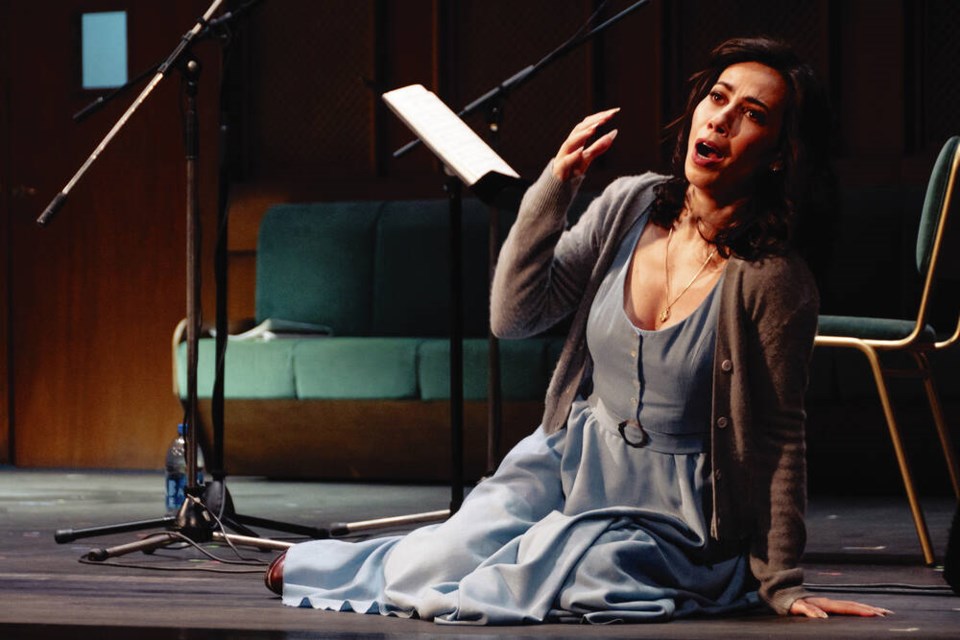How to do you solve a problem like Cosi fan tutte? Well, you could try setting it an East German recording studio.
Pacific Opera Victoria’s new co-production of the beloved Mozart opera, teleported to the late ’50s/early ’60s, boasts a set inspired by Funkhaus Berlin, a famous German studio and concert venue. Onstage we see oodles of mid-century wood panelling and an abundance of music stands and microphones.
Such a setting may seem a touch peculiar, given that Cosi fan tutte is a 1790 opera buffa originally set in Naples. So what’s up?
Simply put, a work like this presents a problem in a post-feminist age. It’s not the music, which is wonderful. The devil lies within the narrative. The Funkhaus Berlin concept was spearheaded by director/costume designer Laurent Pelly and set designer Chantal Thomas. The idea is to distance us from a storyline that some contemporary audience members may view as misogynistic … even offensive.
In Cosi fan tutte two men test their fiancées’ fidelity by donning disguises and pretending to be visiting strangers. In this guise they attempt to seduce their lovers. When the women succumb, the men reveal themselves and harshly denounce their partners’ unfaithfulness. One quips: “If they would only drink poison, these vixens without honour!”
Vixens indeed. These days that kind of language doesn’t fly. And besides, the women aren’t particularly to blame. Ferrando and Guglielmo do a first-rate job of gaslighting Fiordiligi and Dorabella into infidelity, with an assist from their buddy Don Alfonso.
“Cosi fan tutte” can be roughly translated as “women are like that.” In other words, when it comes to signoras and amore, scruples go out the window. Of course in 2023 we no longer agree with any such assessment, not even in fun (just as we no longer view The Taming of the Shrew as a helpful how-to on dealing with feisty women).
Despite its potential to offend some who are hell-bent on viewing historic works through a modern lens, there’s still a reluctance to relegate Cosi fan tutte to the operatic slag heap. It’s one of Mozart’s masterpieces — the music is flabbergastingly beautiful. And most of us still enjoy seeing it on stage.
Cosi fan tutte is Pacific Opera Victoria’s first international co-production. With different casts, this production has been staged by Theatre des Champs-Elysees (France), Tokyo Nikikai Opera (Japan) and Theatre de Caen (France).
As the Victoria Symphony plays the overture, the curtain rises on singers warming up in the studio. Headphoned engineers in the control room ready themselves. The backstage clutter includes harp and drum cases. The dress is business casual: the men wear sports coats, the women are in dresses.
The metatheatre concept in this adaptation is that we’re witnessing an opera within an opera. The cast takes on the roles of opera singers who, in turn, are playing characters in an archaic work of art. (Think of those Russian nesting dolls.) The notion is that we’re now able to view Cosi fan tutte’s plot with a disengaged sense of irony. Therefore, the misogynistic sub-text is not intended to be taken seriously.
How well such a lofty concept works in practice is a matter of debate. On Wednesday night at the Royal Theatre (the opera continues Sunday and Tuesday) I wondered whether the Funkhaus Berlin setting really made much sense. At intermission someone else echoed the same thought, but added: “What does it matter — the music is so wonderful.”
And so it is. In Victoria it’s a young cast, mostly Canadian. Some will remember soprano Lucia Cesaroni from past POV performances. A vivacious performer blessed with a lush voice, she again impressed as Fiordiligi. Cesaroni managed to pole-vault her way through the notoriously difficult Come Scoglio with its mind-boggling highs and lows. Nigglers may have found the coloratura a touch laboured, yet overall the effect was enchanting, here and elsewhere.
Hongni Wu (Dorabella) is a highly accomplished soprano with a keening timbre and enviable technique. Her duet Il core vi dono (“I give you my heart”), with baritone Christopher Dunham as Guglielmo, truly found the opera’s emotional core, thanks to fine singing and intimate staging.
Owen McCausland as Ferrando impressed with his lovely rendition of Un’aura amorosa (“a loving breath”). He’s a lyrical tenor, not without heft, with a knack for exquisite phrasing. Phillip Addis, playing Don Alfonso, is a veteran baritone who sang well and boasted a strong stage presence.
Soprano Cecile Muhire is well cast as Despina the maid. Muhire possesses a flair for physical comedy — her over-the-top antics were among the opera’s most amusing.
Under Timothy Vernon’s baton the Victoria Symphony navigated everything from subtle harpsichord tinkles to full orchestra swoops and other flights of fancy. It’s a delightful score — layered, nuanced, harmonically rich, with astonishing interplay between singers and instrumentalists.
Cosi fan tutte isn’t exactly an action-packed opera — the men may threaten to stab themselves but they never quite get around to it. Perhaps to compensate, the director has introduced a never-ending stream of stage business. The performers are continually doing funny little bits, whether it be Guglielmo and Ferrando’s Laurel-and-Hardy dance moves or Muhire’s mock-macho hip thrusts.



